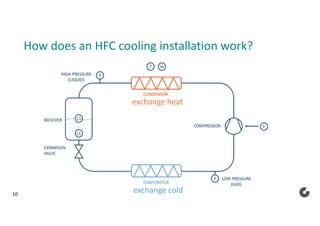Colruyt: Intelligent Leak Detection for HFC Cooling Installations
- 1. 1
- 2. Intelligent Leak Detection for HFC Cooling Installations Margo Parmentier
- 3. 3 Cooling @ Colruyt Group
- 4. 4 Cooling @ Colruyt Group >50engineers >20cooling technicians
- 5. 5 #4. #7. Source: Project Drawdown HFC Natural Refrigerant Sustainable cooling can curb climate change
- 6. 6 How does an HFC cooling installation work? exchange cold exchange heat
- 7. 7 Cooling @ Colruyt Group
- 8. 8 HFCs are very carbon-intensive Refrigerant GWP CO2 1 R507A 4775 R290 (propane) 0.02 > 200 shops
- 9. 9 Leakage of HFC refrigerants accounts for 10% of Colruyt Group’s total CO2 emissions in 2020
- 10. 10 How does an HFC cooling installation work? exchange cold exchange heat
- 11. 11 Why do we even need this receiver? LS LS
- 12. 12 The receiver is the key to detect a leak! LS RECEIVER LS
- 13. 13 LS LS LT We installed a level transmitter in OKay Huizingen to monitor the natural fluctuations
- 14. 14 Almost all other locations only have the 2 level switches LS LS
- 15. 15 y Electricity consumption Outside temperature HFC level in receiver Wind speed Opening hours Defrost timing X
- 17. 17 When an anomaly is detected, we send an alarm to the maintenance department
- 18. 18 Sending a technician to look for an actual leak is difficult and expensive
- 19. 19 This is what the first detected leak looked like on paper in Colruyt Zottegem in October 2020 Relative level in the receiver Time [per hour]
- 20. 20 …and the second leak in Colruyt Haaltert a few days later Time [per hour] Relative level in the receiver Inspection glass level
- 21. 21 This is what the leak in Colruyt Zottegem looked like in real life
- 22. 22 We are able to discover leaks much faster than before! 12 leaks detected since October 2020 9% leaks away before a technician fixes the leak with our detection system 19% leaked away before a technician fixes the leak before we deployed our detection system
- 23. 23 One year after the first leak detection: 58 installations monitored 2800 tons CO2 equivalent avoided in 2021 compared to 2020 2.5% of Colruyt Group’s total emissions
- 24. 24 Thank you!



















![19
This is what the first detected leak looked like
on paper in Colruyt Zottegem in October 2020
Relative
level
in
the
receiver
Time [per hour]](https://image.slidesharecdn.com/colruytgroupdatascienceleuvenmeetup300921-211004121923/85/Colruyt-Intelligent-Leak-Detection-for-HFC-Cooling-Installations-19-320.jpg)
![20
…and the second leak in Colruyt Haaltert
a few days later
Time [per hour]
Relative
level
in
the
receiver
Inspection glass level](https://image.slidesharecdn.com/colruytgroupdatascienceleuvenmeetup300921-211004121923/85/Colruyt-Intelligent-Leak-Detection-for-HFC-Cooling-Installations-20-320.jpg)



